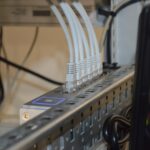What is edge computing? Have you ever asked yourself this question when you hear this word? The world is changing every day, and we must change with it, starting by understanding basic concepts, which we are sure will become part of our daily life in the future.
Currently, we are in the era of cloud computing, where all devices have become electric and automated. In the digital future, this will increase considerably, so good management of the millions and millions of data that will be generated will be needed. This is where Edge Computing comes in.
As we are here to help you, we will introduce you to Edge Computing and its advantages. In addition, we will present a comparison between Edge Computing and Cloud Computing and answer your question: is edge the new revolution in data processing? Stay with us to learn this and more!
We invite you to connect with this note and feel how your brain becomes a big cloud storing information. Let’s start processing data!
What is Edge Computing?
When we talk about Edge Computing, we refer to a mesh network of micro data centers that process and store data locally and then send it to a central data center.
Edge computing has a direct relationship with the internet of things: that great mass of connected devices that are entering our homes and offices. It can be anything, a refrigerator, an electric lamp, an electric skateboard, televisions, security cameras, etc.
All these objects are connected to the network, generating millions of data. This data is then sent to the database in the cloud. Then, that data is processed in order to gather the information that allows improving the system little by little. This process is known as Cloud Computing.
However, this whole procedure is slow and does not provide rapid improvements; it is also expensive and consumes a lot of energy. This is precisely what Edge Computing improves.
Edge Computing vs. Cloud computing
Although Edge Computing and Cloud Computing concepts are closely related, they are not exactly the same. Therefore, it is useful to compare their definitions and thus understand their differences.
Both are related to distributed computing, as they focus on the physical deployment of computing resources and the storage of the data they produce. The difference is in where they are located.
Cloud computing has focused on centralizing cloud services in a group of large data centers. On the other hand, Edge computing takes care of the practical cases that the centralization approach of Cloud Computing cannot adequately address.
Also, Edge Computing is computing that is done at or near the source of the data, thus not relying on the cloud, which has only a dozen or so data centers to do all the work.
This does not mean that the cloud will disappear; it means that the cloud is coming to you.
As Eric Knorr rightly mentions in his publication in Network World, “This growing Internet of Things is already collecting petabytes of data, some of it processed for analysis and some of it immediately actionable. Then an architectural problem arises: you don’t want to connect all those devices and transmit all that data directly to some centralized cloud or enterprise data center. The latency and data transfer costs are too high.”
Advantages of Edge Computing
It is important to understand that thanks to edge computing, users have the ability to process and store data. Through this, we can virtualize server capabilities and enable processing power to occur on these devices.
Because of this, we get great benefits from edge computing:
- Faster, more stable services at a lower cost.
- Faster and more consistent user experience.
- Low-latency, high-availability applications with continuous monitoring for enterprises and providers.
- Lower network costs.
- Avoid bandwidth constraints.
- Control the transfer of sensitive data.
- Ability to aggregate and analyze big data on-premises, enabling near-immediate decision making.
- Reduce the risk of allowing access to sensitive data.
How does Edge Computing benefit a company?
With edge computing, companies can use and distribute a pool of resources across a large number of locations. Today, data is the lifeblood of modern business, without it, it would be impossible to manage the vast sea of information they handle.
Edge computing allows them to support real-time control of business processes and operations, which can be in use for businesses from manufacturing plants to essay writers like me. In addition, they can collect large amounts of data continuously from sensors and devices operating anywhere in real-time.
In enterprise computing, data is produced at a client endpoint, such as a user’s computer, this data moves over a WAN such as the internet or across a corporate LAN, and the results of this work are sent to the cloud.
Edge computing seeks to reduce the arduous work of moving so much data in situations that are often not the most beneficial because of the time or disruptions it puts on the global internet, so it is usually congested or intermittent.
Examples of Edge Computing
Easy recognition in airports
The data obtained by facial recognition in airports allows controlling that passengers do not have judicial problems.
Modern manufacturing plant
In these, the internet of things sensors generate a constant flow of data that can be used to prevent breakdowns and damage; in this way, processes and operations can be optimized.
Transportation that is connected to the Internet
They are another example of Edge Computing, and these have computers that track passenger flow and service delivery. In fact, carriers can leverage integrated technology to find more efficient routes.
Nearby 5G cell phone antennas
Telecom providers have become more common to run their networks with virtualization of network functions, whereby they use virtual machines that allow providers to run system software in tens of thousands of remote locations through an Edge Computing strategy.






